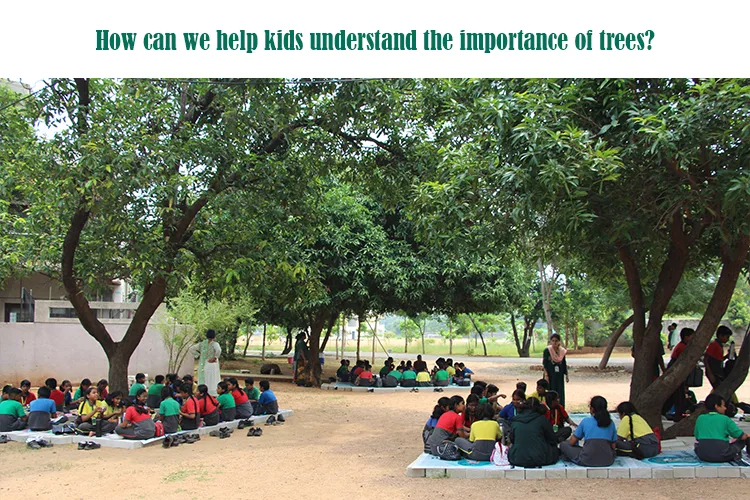The importance of educating children in relation to trees is not just literacy about nature, but an educational perspective on the world that they live in; it really is comprehensive. With this post, we will discuss some of the ways to make kids understand trees and why holistic education matters for this.
Why are trees good for people?
Trees are not the passive fixtures we typically think of in landscape settings, they are dynamic organisms that offer so many ecological services to the planet and its trophic levels. As kids learn these benefits they are establishing themselves as accountable and educated citizens. Almost 15 billion trees are lost every year due to deforestation. The Green Belt movement started by Wangari Maathai is been a global phenomenon for a long time.
More than just pretty pictures
- Trees are the lungs of the earth as during the process of photosynthesis trees give oxygen and take away carbon dioxide with many other harmful gases. A tree absorbs almost 22 KG of carbon dioxide in a year which helps to control climate change and pollution.
- Trees are been fostering biodiversity for a long time as it is a naturally habitable for birds, insects, and mammals which makes Earth a stable and healthy planet. The forest is a safe and sweet home for 80% terrestrial animals like monkeys, chimpanzees etc.
- Trees offer us timber, fruits & medicinal plants. It also sustains livelihoods through the sectors of forestry and agriculture. In a region where agriculture is one of the biggest components of the local economy, teaching children about the economic value of trees can enlighten them to not mess up with sustainable resource management.
- Trees have been one of the significant components in human societies for ages and are central to our cultures and religions. They are places of shade and scenery. We can make children connect with heritage and imbibe the cultural history.
Holistic nature of education
1. Experiential learning:
Holistic education is a philosophy of learning that aspires to provide comprehensive development in the spirit, mind and body of a person or students. It includes all intellectual and social education for personal growth. Misunderstanding the value of trees can be reversed through a holistic approach to education.
2. Interdisciplinary approach:
Children should not only learn about trees through textbooks, but they should have hands-on experience interacting with them, such as nature walks in parks, green fields, tree plantations or botanical garden visits. Kids can experience trees and nature in sensory ways so that they feel a deeper relationship with them. Trees as a concept can be taught in terms of related subjects like science, social studies and language arts (even mathematics). A child might not only study the biology of trees in science class but the history of reforestation in social studies, write poems about trees in language arts or calculate the age of a tree using rings through mathematics. Such an interdisciplinary approach can help children to see the study of knowledge across subjects and make a more inclusive view of all around the world.
3. Community engagement:
The involvement of children in community-level tree programs instils a sense of ownership and civic pride. This may include participation in local tree planting projects, running campaigns for the awareness of tree plantation or working alongside local organisations to safeguard green cover. If children get involved in their community, they will feel like they have ownership and pride over their surroundings.
4. Emotional connection:
Holistic education also involves taking an emotional attachment to mother nature. It is done through various outdoor activities such as nature journaling or art inspired by nature, walking in trees all by themselves together and such.
Practical steps to involvement of children
Some of the practical steps that parents and teachers can take to make children understand why trees are important are as follows:
Well-organised nature walks and tree plantation :
The very first practical step to help kids to be involved in tree plantation is to have structured nature walks which creates a bonding with nature. The basic knowledge of trees from germination to how they cook their food will encourage students to choose nature walks and participate actively in tree plantation. The hands-on experiences grant students to understand their role in this matter.
Include tree education into the academic framework
The schools and educational institutions play a huge role in encouraging students to participate in different tree plantation programmes around the local community and decide the role of students to build a better environment for them. Incorporating education related to the environment or soil, air, water or trees or different articles related to trees, or subjects such as science, geography, art and literature will help to take further steps towards a better tomorrow.
Establish environmental clubs take initiative and have campaigns
Inspire and welcome students to have an environmental club and join them with the initiative to have more greenery around them with better campaigns and recycling programs. This idea will make them an agent of change.
Creatively design interactive classrooms and materials
The best part of learning about the environment is having fun with games, and books and interacting with students through different aspects of teaching or learning. Educational digital tools such as websites, posters and banners, software and apps such as tree identification apps are important to raise awareness among people.
Workshops with Experts and recreate green spaces
The real and pragmatic step towards the cause to involve children to understand the values of the tree is to collaborate with local clubs, NGOs and environmental organisations to arrange workshops or lessons on the topic where children can learn from experts freely through different conversations, experiments and experiences. Furthermore, having education trips to the nearest park or garden can help in this matter.
The Role of Trees in Warangal
The role of trees is very important in shaping the ability to maintain the same level of sustainability among communities with a better understanding of values with growth and development in cities such as Warangal. The idea of urban forestry as a global model can be inspirational for Warangal to harmonise more trees in cityscapes. Different cities in India are successfully applying it to reduce pollution and a better residential life. Moreover, the global movement to plant trees on different occasions or festivals to fight deforestation has gained motion and a lot of actions towards it have been seen towards it.
The “UNEP” or UN has taken action to plant trees all over the world in 2006 and 13 billion trees are been planted so far to address deforestation, climate change and pollution. This initiative not only plants trees but also protects trees from inception. DPS Warangal students can Join this campaign and contribute towards a better future.
A well-rounded educational approach can assist in forging a deeper relationship with nature, community, and the importance and necessity of why trees are important to who we are as people, and as communities, vital for the health of our world as a whole. Warangal is yet to emerge from its self-imposed cocoon and is ready to move on. Helping children understand why trees are important is not just about science or environmental education but also the real holistic development of a responsible and active citizen. Schools with a focus on holistic education in Warangal can play a key role in this transformative learning process.


